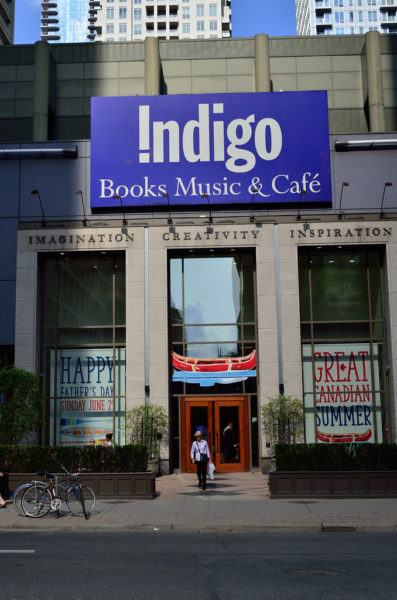In the latest SHuSH newsletter, Ken Whyte discusses Indigo’s latest earnings report and points out a few things that may indicate better things to come if the firm continues its “refocus” on bookselling as its primary line of business:

“Indigo Books and Music” by Open Grid Scheduler / Grid Engine is licensed under CC0 1.0
Indigo Books & Music last week reported its third quarter financial results, covering the months of October to December 2023. Because retailers make most of their money in advance of the holiday season, Indigo’s third quarter is its most important quarter — the one that makes or breaks the year. It wasn’t good.
Revenue for the three-month period was $371 million compared to $423 million in the same period last year. Net income for the quarter was $10 million compared to $34.3 million in the prior year. Given that the company had already lost more than $40 million in the first two quarters of the year and that its fourth quarter is traditionally soft, Indigo is looking at another annus horribilis come its March 31 year end.
After every quarter, Indigo’s CEO and CFO discuss the company’s results and take questions from shareholders on a conference call. I tuned in to this quarter’s call to hear company founder Heather Reisman, recently returned as CEO, admit that it was a “challenging” time for the business. She attributed the poor performance to the ongoing repercussions of last winter’s ransomware attack, overbuys of the wrong kind of general merchandise (non-book items such as dildos, blankets, and cheeseboards), and “the premature launch of our new e-commerce platform”.
Amid all the ugly results, I heard a few things that might strike anyone interested in the Canadian book publishing industry as positive.
You’ll remember that Heather spent a few months in the doghouse last summer after announcing a terrible fiscal 2023. She retired and then un-retired in September and, on her return, pledged to take SHuSH‘s advice, clear her shelves of the dildos and cheeseboards that represent half of Indigo’s business, and recommit to selling books. I wasn’t sure if she meant it or just wanted the business community to know she was up on SHuSH. Apparently she meant it.
On the call, she spoke at length of her “transformation plan” to “connect meaningfully with book lovers”. She apparently spent the autumn shrinking her general merchandise inventory — much of the poor financial performance was due to unloading it at steep discounts. In fact, if you back out the aggressive discounting of unwanted crap, Indigo’s recent holiday season hit a slightly higher level of profitability than the prior year. Heather meanwhile reinvested in book inventory, “consistent with our long-term brand mission to inspire reading”.
I was heartened by this, more so when it emerged on the call that there are sound business reasons for recommitting to books. The printed word turned out to be Indigo’s most resilient retail channel last year. It was down only 8 percent. General merchandise was down 18.5 percent. Heather thinks general merchandise was hit especially hard because the guy she’d hired to run the place in her absence didn’t have the right assortment in stores at Christmas. That may be true, but 18.5 percent is still a big drop.
The 8 percent decline in books looks okay in relation to the rest of Canada’s retail economy. Canadian Tire just announced its results from the last quarter of 2023 and revenue was down 17 percent across the board. That suggests books more than held their own in a weak environment.
It seems reasonable to expect that if Indigo follows through on Heather’s promise and refocuses its brand and its marketing efforts and its in-store experience on books and reading, the business has a future. It will take time, as she repeatedly reminded listeners on the call. There’s still a canopy bed in the middle of the company’s flagship bookstore in Ottawa.




